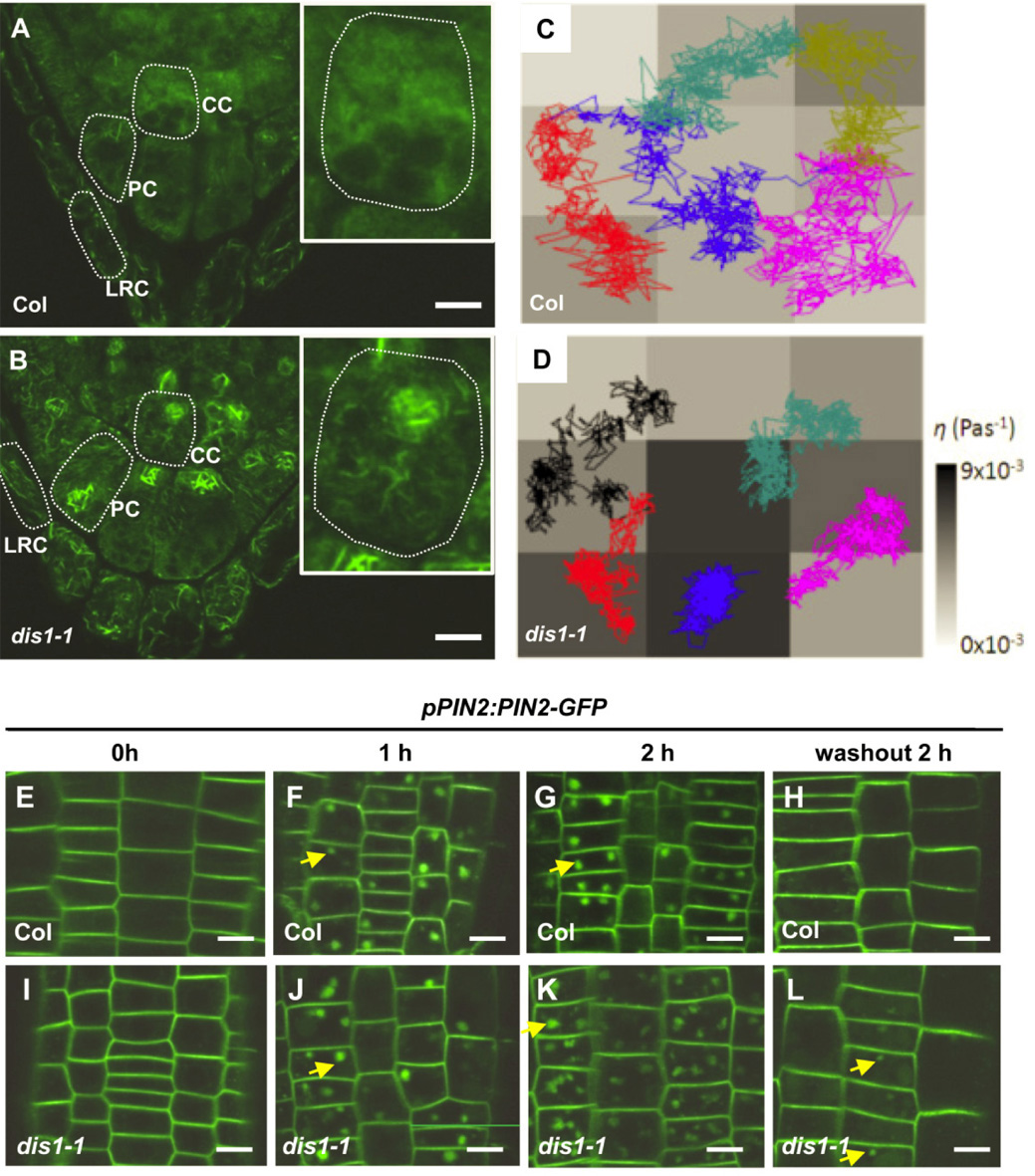J Exp Bot:中科院植物所乐捷研究组等揭示植物微丝细胞骨架相关蛋
2016年7月29日,国际植物学知名刊物《Journal of Experimental Botany》上在线发表了中国农业科学院中国科学院植物研究所乐捷研究组的一篇研究论文,研究揭示了微丝细胞骨架在植物重力感知、信号传递中的功能,对于进一步揭示植物发育和形态建成的调控机制,以及改良作物株型、抗倒伏等农艺性状提供了新的研究方法和理论依据。助理研究员邹俊杰为论文第一合作作者,乐捷研究员和中科院力学研究所王育人研究员论文共同通讯作者。
重力是重要的地球环境因素之一,植物在长期的进化中形成了特有的重力感知和响应机制来调控植物发育和形态建成(如根的向地性生长和地上部的背地性直立生长),保障了植物可以有效地利用营养、水分和光能。已有较多的研究结果表明,微丝细胞骨架在植物响应重力变化中起到重要作用;但是由于以往研究中所用的微丝抑制剂、研究材料、植物器官的不同,至今仍没有明确的有关微丝细胞骨架如何参与植物重力响应的精细机制。根据“淀粉体-平衡石”假说,植物感重细胞(如根尖小柱细胞和茎内皮层细胞)内的淀粉体在感知重力变化后发生沉降,可迅速将物理信号转化为生物化学信号。由于感重细胞内存在着复杂的亚细胞结构(如细胞骨架和内膜系统等),造成了淀粉体运动复杂的力学特性。
乐捷研究组应用流体力学微流变方法分析了拟南芥根尖感重细胞内淀粉体的运动特性,用此方法对植物根的重力研究之前未见报道。研究人员发现,在重力刺激(旋转90度)下野生型感重细胞内的淀粉体运动具有明显的“牢笼-逃逸(cage-escape)”和协同运动的力学效应。在ARP2/3微丝相关蛋白复合体突变体(dis1-1, dis2-1)的根尖感重细胞中,由于淀粉体被异常形成的粗微丝束所束缚和分离,缺少明显的淀粉体“牢笼-逃逸”和协同运动;而微丝解聚剂(Latrunculin B)预处理可以显著地打破微丝突变体中存在的淀粉体运动的“牢笼”效应。进一步的研究结果表明,ARP3/DIS1亚基不仅参与感重细胞内的重力感知,还参与了重要的重力信号——生长素的胞间传递。在dis1-1突变体中,多个生长素运输载体PIN家族蛋白(PIN2、PIN3、PIN7)在胞内的运转发生异常,影响了生长素在根上、下两侧细胞内不对称分布的迅速建立,造成根的向地弯曲生长延迟。
2015年研究组在molecular Plant期刊发表的另一篇相关文章“Microrheological Insights into the Dynamics of Amyloplasts in Root Gravity-Sensing Cells”也介绍了相关的研究情况。

植物微丝细胞骨架相关蛋白ARP3参与根重力响应中的重力感知和生长素运转
(A-D)微流变技术分析发现拟南芥ARP3突变体dis1-1根尖中央感重细胞内存在较高的区域表观粘度,微丝束对淀粉体运动形成较强的“牢笼”力学效应。(E-L)Brefedlin A药剂处理后,ARP3突变体dis1-1中生长素运输蛋白PIN2-gfp在胞内的异常积累消失缓慢。
原文链接:
The role of ArABIdopsis Actin-Related Protein 3 in amyloplast sedimentation and polar auxin transport in root gravitropism
原文摘要:
Gravitropism is vital for shaping directional plant growth in response to the forces of gravity. Signals perceived in the gravity-sensing cells can be converted into biochemical signals and transmitted. Sedimentation of amyloplasts in the columella cells triggers asymmetric auxin redistribution in root tips, leading to downward root growth. The actin cytoskeleton is thought to play an important role in root gravitropism, although the molecular mechanism has not been resolved. DISTORTED1 (DIS1) encodes the ARP3 subunit of the Arabidopsis Actin-Related Protein 2/3 (ARP2/3) complex, and the ARP3/DIS1 mutant dis1-1 showed delayed root curvature after gravity stimulation. Microrheological analysis revealed that the high apparent viscosity within dis1-1 central columella cells is closely associated with abnormal movement trajectories of amyloplasts. Analysis using a sensitive auxin input reporter DII-VENUS showed that asymmetric auxin redistribution was reduced in the root tips of dis1-1, and the actin-disrupting drug Latrunculin B increased the asymmetric auxin redistribution. An uptake assay using the membrane-selective dye FM4-64 indicated that endocytosis was decelerated in dis1-1 root epidermal cells. Treatment and wash-out with Brefeldin A, which inhibits protein transport from the endoplasmic reticulum to the Golgi apparatus, showed that cycling of the auxin-transporter PIN-FORMED (PIN) proteins to the plasma membrane was also suppressed in dis1-1 roots. The results reveal that ARP3/DIS1 acts in root gravitropism by affecting amyloplast sedimentation and PIN-mediated polar auxin transport through regulation of PIN protein trafficking.
作者:乐捷

